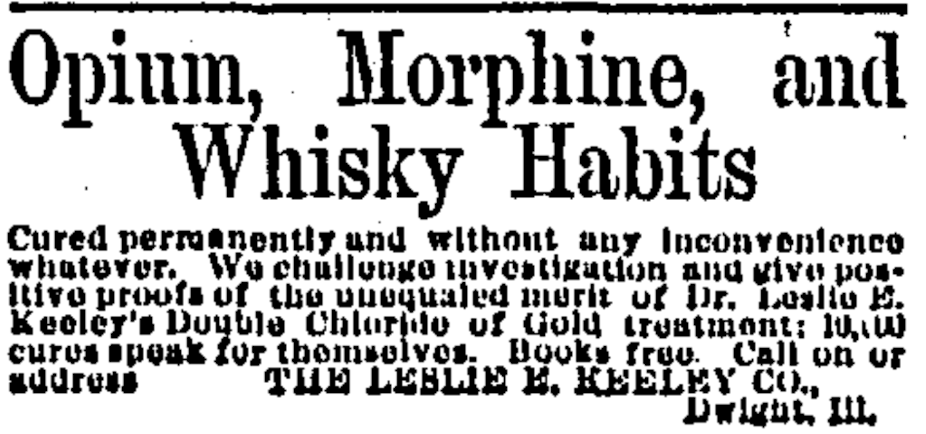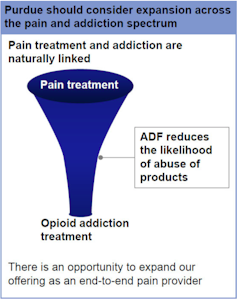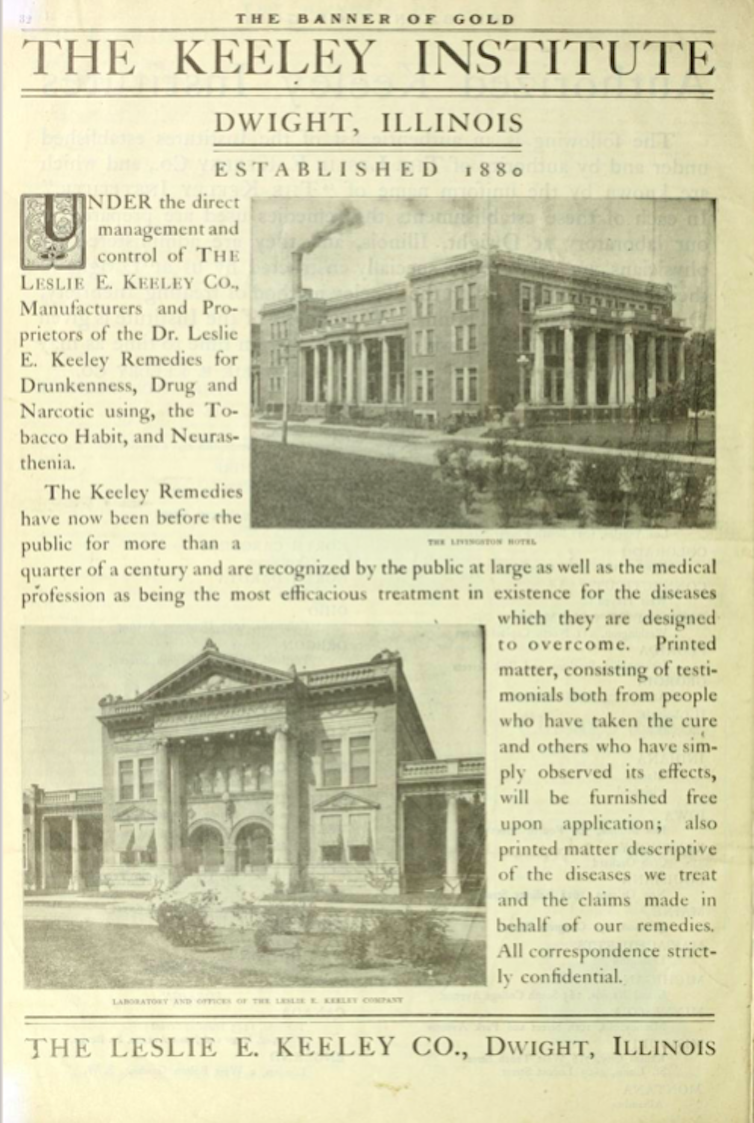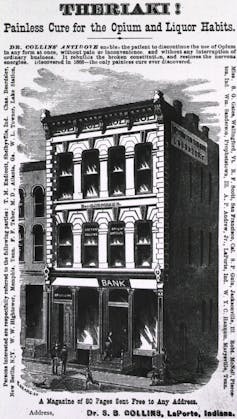March 4, 2019 Jonathan S. Jones


Classified advertisement for Leslie Keeley’s Gold Cure.
ProQuest Historical Newspapers: Chicago Tribune, July 21, 1884
Newly unsealed documents from a lawsuit by the state of Massachusetts allege that Purdue Pharma, maker of OxyContin and other addictive opioids, actively sniffed out new, sinister ways to cash in on the opioid crisis.
Despite years of negative press coverage, unwanted attention from regulators, multi-million dollar fines and several major lawsuits, Purdue staff and owners sought to expand the company’s sights beyond its usual array of opioid painkillers. Purdue planned to become an “end-to-end pain provider,” by branching into the market for opioid addiction and overdose medicines, looking to peddle these medicines even while the company continued to aggressively market its addictive opioids. Internal research materials coldly explained the rationale behind this plan: “Pain treatment and addiction are naturally linked.”
As thousands of Americans continue to overdose on opioids annually, Purdue’s secret marketing research predicted that sales of naloxone, the overdose reversal drug, and buprenorphine, a medicine used to treat opioid addiction, would increase exponentially. Addiction to Purdue’s opioids would thus drive the sale of the company’s opioid addiction and overdose medicines. Purdue even planned to target as customers patients already taking the company’s opioids and doctors who prescribed opioids excessively, according to the Massachusetts lawsuit filing. To keep the plan quiet, Purdue staff dubbed the scheme “Project Tango.”
Newly unsealed documents from a lawsuit by the state of Massachusetts allege that Purdue Pharma, maker of OxyContin and other addictive opioids, actively sniffed out new, sinister ways to cash in on the opioid crisis.
Despite years of negative press coverage, unwanted attention from regulators, multi-million dollar fines and several major lawsuits, Purdue staff and owners sought to expand the company’s sights beyond its usual array of opioid painkillers. Purdue planned to become an “end-to-end pain provider,” by branching into the market for opioid addiction and overdose medicines, looking to peddle these medicines even while the company continued to aggressively market its addictive opioids. Internal research materials coldly explained the rationale behind this plan: “Pain treatment and addiction are naturally linked.”
As thousands of Americans continue to overdose on opioids annually, Purdue’s secret marketing research predicted that sales of naloxone, the overdose reversal drug, and buprenorphine, a medicine used to treat opioid addiction, would increase exponentially. Addiction to Purdue’s opioids would thus drive the sale of the company’s opioid addiction and overdose medicines. Purdue even planned to target as customers patients already taking the company’s opioids and doctors who prescribed opioids excessively, according to the Massachusetts lawsuit filing. To keep the plan quiet, Purdue staff dubbed the scheme “Project Tango.”

According to the Massachusetts lawsuit, Purdue used this graphic in its internal strategy materials to illustrate Project Tango. State of Massachusetts, CC BY-SA
The audacity of Project Tango enraged many observers. But considered in historical context, the news that Purdue sought to peddle opioid addiction medicines while continuing to sell opioids seems less surprising. In fact, there is clear historical precedent for Purdue’s business plan. Over a century ago, “patent medicine” sellers pioneered this strategy during the U.S.’s Gilded Age opiate addiction epidemic.
Opiate addiction in the Gilded Age
Opiates were some of the most commonly prescribed medicines in American history until the 20th century. Pills containing opium, hypodermic morphine injections and laudanum, a drinkable liquid concoction of opium and alcohol, constituted half or more of all medicines prescribed in American hospitals during most of the 19th century, according to research by the historian John Harley Warner. Opiates were also present in countless “patent medicines,” over-the-counter panaceas made of secret ingredients, often sold under catchy brand names like Mrs. Winslow’s Soothing Syrup. Americans could choose from 5,000 brands of patent medicines marketed for all manner of ailments by the 1880s. In 1904, just before federal oversight began, patent medicines had matured into an astonishingly profitable industry, with estimated sales at US$74 million dollars annually – equivalent to about $2.1 billion dollars today.
Opiate-laced prescriptions and patent medicines often caused addiction. The historian David T. Courtwright estimates that opiate addiction rates in the U.S. skyrocketed to 4.59 per thousand Americans by the 1890s – a high rate, although lower than the rate of fatal opioid overdoses in recent years. Most individuals developed addictions through medicines, rather than the infamous smoking variety of opium. Victims of “the habit” cut across demographic lines, encompassing middle-class housewives suffering from menstrual pain, Civil War veterans reeling from amputations and many others in between.
Yet even for those who became addicted to prescription opiates, the condition was socially stigmatized and physically dangerous. Like today, addiction to opiates often led to fatal overdose, condemnation and sometimes even involuntary commitment to mental asylums. As one doctor reported to the Iowa Board of Health in 1885, addicted people lived “truly in a veritable hell.”
To avoid these frightful outcomes, desperate, opiate-addicted Americans frequently sought out medical treatment for their condition.
Gilded Age Americans could choose from a range of therapies for opiate addiction. Wealthy patients frequented plush private clinics, where they could receive inpatient treatment for opiate addiction. The most popular were the Keeley Institutes, which offered patients injections of the “Bichloride of Gold” remedy, invented by the doctor Leslie Keeley.
Scores of Keeley Institutes sprang up around the country in the late 19th century, a testament to the popularity of Keeley’s “Gold Cure,” which he marketed for alcoholism and drug addiction. No up-and-coming Gilded Age city was complete without a Keeley Institute. At the height of the Gold Cure craze, there were 118 institutes serving 500,000 Americans between 1880 and 1920. Even the federal government had a contract with Keeley to provide the Gold Cure to addicted veterans. Although injections of the Gold Cure had little intrinsic medical value, historians believe that socializing with other like-minded patients in the Keeley Institutes may have helped some patients recover from addiction.
The audacity of Project Tango enraged many observers. But considered in historical context, the news that Purdue sought to peddle opioid addiction medicines while continuing to sell opioids seems less surprising. In fact, there is clear historical precedent for Purdue’s business plan. Over a century ago, “patent medicine” sellers pioneered this strategy during the U.S.’s Gilded Age opiate addiction epidemic.
Opiate addiction in the Gilded Age
Opiates were some of the most commonly prescribed medicines in American history until the 20th century. Pills containing opium, hypodermic morphine injections and laudanum, a drinkable liquid concoction of opium and alcohol, constituted half or more of all medicines prescribed in American hospitals during most of the 19th century, according to research by the historian John Harley Warner. Opiates were also present in countless “patent medicines,” over-the-counter panaceas made of secret ingredients, often sold under catchy brand names like Mrs. Winslow’s Soothing Syrup. Americans could choose from 5,000 brands of patent medicines marketed for all manner of ailments by the 1880s. In 1904, just before federal oversight began, patent medicines had matured into an astonishingly profitable industry, with estimated sales at US$74 million dollars annually – equivalent to about $2.1 billion dollars today.
Opiate-laced prescriptions and patent medicines often caused addiction. The historian David T. Courtwright estimates that opiate addiction rates in the U.S. skyrocketed to 4.59 per thousand Americans by the 1890s – a high rate, although lower than the rate of fatal opioid overdoses in recent years. Most individuals developed addictions through medicines, rather than the infamous smoking variety of opium. Victims of “the habit” cut across demographic lines, encompassing middle-class housewives suffering from menstrual pain, Civil War veterans reeling from amputations and many others in between.
Yet even for those who became addicted to prescription opiates, the condition was socially stigmatized and physically dangerous. Like today, addiction to opiates often led to fatal overdose, condemnation and sometimes even involuntary commitment to mental asylums. As one doctor reported to the Iowa Board of Health in 1885, addicted people lived “truly in a veritable hell.”
To avoid these frightful outcomes, desperate, opiate-addicted Americans frequently sought out medical treatment for their condition.
Gilded Age Americans could choose from a range of therapies for opiate addiction. Wealthy patients frequented plush private clinics, where they could receive inpatient treatment for opiate addiction. The most popular were the Keeley Institutes, which offered patients injections of the “Bichloride of Gold” remedy, invented by the doctor Leslie Keeley.
Scores of Keeley Institutes sprang up around the country in the late 19th century, a testament to the popularity of Keeley’s “Gold Cure,” which he marketed for alcoholism and drug addiction. No up-and-coming Gilded Age city was complete without a Keeley Institute. At the height of the Gold Cure craze, there were 118 institutes serving 500,000 Americans between 1880 and 1920. Even the federal government had a contract with Keeley to provide the Gold Cure to addicted veterans. Although injections of the Gold Cure had little intrinsic medical value, historians believe that socializing with other like-minded patients in the Keeley Institutes may have helped some patients recover from addiction.

Advertisement for the main Keeley Center, in Dwight, Illinois, 1908.
Keeley faced stiff competition, however. Other popular therapies for opiate addiction included patent medicine “cures” and “antidotes,” which were cheaper than inpatient care. These could be ordered by mail without a prescription, and consumed in the privacy of one’s home, away from prying eyes.
Fueled by high demand, during its heyday at the turn of the 20th century, addiction cures bloomed into a multimillion-dollar sector of the patent medicine industry. Dozens of pharmaceutical companies peddled their “cures” to willing, opiate-addicted customers, which they marketed through pamphlets, postcards, and newspaper and magazine classifieds.
Ironically, these “cures” for opiate addiction almost universally contained opiates, unbeknownst to hopeful customers, who received little therapeutic benefit by today’s standards. But in an era before federal regulation of medicines and narcotics, there were no effective safeguards to protect addiction patients from medical fraud.
Pharmaceutical fraud
Much like Purdue Pharma, which famously marketed Oxycontin as non-addictive precipitating the opioid crisis, Gilded Age patent medicine companies also fraudulently marketed their addiction treatments as non-addictive, targeting and intentionally deceiving addicted customers. For their part, Gilded Age doctors were deeply skeptical of such products, and they often accused proprietors of fraud in medical journals and newspapers.
Samuel B. Collins of La Porte, Indiana, inventor of the “Painless Opium Antidote,” one of the era’s most popular brands, insisted that his product was not addictive. Collins was proven a fraud, however, by a skeptical Maine doctor, who in 1876 sent off a sample of Collins’ product to several chemists for analysis. Their tests indicated that the Painless Opium Antidote contained enough morphine to perpetuate opiate addiction, actually fueling demand for Collins’s product, rather than curing the underlying addiction.
Despite the overwhelming evidence, however, without any effective medical regulation or oversight, Collins maintained his fraud for decades. His business strategy presaged Purdue’s Project Tango by targeting vulnerable opiate-addicted individuals. Advertisement for Theriaki, a painless cure for the opium habit. Exterior view of Dr. Collins’ Opium Antidote Laboratory, LaPorte, Indiana. National Library of Medicine
Advertisement for Theriaki, a painless cure for the opium habit. Exterior view of Dr. Collins’ Opium Antidote Laboratory, LaPorte, Indiana. National Library of Medicine
After decades of exposés by doctors and journalists, however, the opiate addiction cure trade collapsed during the Progressive Era under mounting public pressure and new federal legislation. One famous “muckraking” exposé, The Great American Fraud by the journalist Samuel Hopkins Adams, pulled back the curtain on the industry of opiate addiction cures for millions of appalled readers. Collier’s ad, Dec., 1905, after the publication of articles on patent medicine fraud. Wikimedia Commons
Collier’s ad, Dec., 1905, after the publication of articles on patent medicine fraud. Wikimedia Commons
Hopkins painted such a scathing portrait of opiate addiction cures, whose proprietors the writer dismissed as “scavengers,” that the American Medical Association paid to disseminate Adams’s reporting as part of a lobbying campaign for the regulation of patent medicines. This strategy paid off. Although far from perfect solutions, the Pure Food and Drug Act of 1906 and the Harrison Narcotics Tax Act of 1914 regulated the ingredients and sale of patent medicines and narcotics, including opiate addiction medicines. These measures ultimately ensured that Collins, Keeley and other patent medicine sellers could no longer prey upon opiate-addicted customers.
Like its Gilded Age predecessors, today’s Big Pharma actively schemes to profit off of vulnerable, addicted customers, even while taking steps to ensure that opioid addiction persists. I believe that only sustained, vigilant oversight can prevent the reemergence of a medical Gilded Age, one in which companies like Purdue Pharma can manufacture an addiction crisis and charge customers for “curing” it.
Keeley faced stiff competition, however. Other popular therapies for opiate addiction included patent medicine “cures” and “antidotes,” which were cheaper than inpatient care. These could be ordered by mail without a prescription, and consumed in the privacy of one’s home, away from prying eyes.
Fueled by high demand, during its heyday at the turn of the 20th century, addiction cures bloomed into a multimillion-dollar sector of the patent medicine industry. Dozens of pharmaceutical companies peddled their “cures” to willing, opiate-addicted customers, which they marketed through pamphlets, postcards, and newspaper and magazine classifieds.
Ironically, these “cures” for opiate addiction almost universally contained opiates, unbeknownst to hopeful customers, who received little therapeutic benefit by today’s standards. But in an era before federal regulation of medicines and narcotics, there were no effective safeguards to protect addiction patients from medical fraud.
Pharmaceutical fraud
Much like Purdue Pharma, which famously marketed Oxycontin as non-addictive precipitating the opioid crisis, Gilded Age patent medicine companies also fraudulently marketed their addiction treatments as non-addictive, targeting and intentionally deceiving addicted customers. For their part, Gilded Age doctors were deeply skeptical of such products, and they often accused proprietors of fraud in medical journals and newspapers.
Samuel B. Collins of La Porte, Indiana, inventor of the “Painless Opium Antidote,” one of the era’s most popular brands, insisted that his product was not addictive. Collins was proven a fraud, however, by a skeptical Maine doctor, who in 1876 sent off a sample of Collins’ product to several chemists for analysis. Their tests indicated that the Painless Opium Antidote contained enough morphine to perpetuate opiate addiction, actually fueling demand for Collins’s product, rather than curing the underlying addiction.
Despite the overwhelming evidence, however, without any effective medical regulation or oversight, Collins maintained his fraud for decades. His business strategy presaged Purdue’s Project Tango by targeting vulnerable opiate-addicted individuals.
 Advertisement for Theriaki, a painless cure for the opium habit. Exterior view of Dr. Collins’ Opium Antidote Laboratory, LaPorte, Indiana. National Library of Medicine
Advertisement for Theriaki, a painless cure for the opium habit. Exterior view of Dr. Collins’ Opium Antidote Laboratory, LaPorte, Indiana. National Library of MedicineAfter decades of exposés by doctors and journalists, however, the opiate addiction cure trade collapsed during the Progressive Era under mounting public pressure and new federal legislation. One famous “muckraking” exposé, The Great American Fraud by the journalist Samuel Hopkins Adams, pulled back the curtain on the industry of opiate addiction cures for millions of appalled readers.
 Collier’s ad, Dec., 1905, after the publication of articles on patent medicine fraud. Wikimedia Commons
Collier’s ad, Dec., 1905, after the publication of articles on patent medicine fraud. Wikimedia CommonsHopkins painted such a scathing portrait of opiate addiction cures, whose proprietors the writer dismissed as “scavengers,” that the American Medical Association paid to disseminate Adams’s reporting as part of a lobbying campaign for the regulation of patent medicines. This strategy paid off. Although far from perfect solutions, the Pure Food and Drug Act of 1906 and the Harrison Narcotics Tax Act of 1914 regulated the ingredients and sale of patent medicines and narcotics, including opiate addiction medicines. These measures ultimately ensured that Collins, Keeley and other patent medicine sellers could no longer prey upon opiate-addicted customers.
Like its Gilded Age predecessors, today’s Big Pharma actively schemes to profit off of vulnerable, addicted customers, even while taking steps to ensure that opioid addiction persists. I believe that only sustained, vigilant oversight can prevent the reemergence of a medical Gilded Age, one in which companies like Purdue Pharma can manufacture an addiction crisis and charge customers for “curing” it.
Author
Jonathan S. Jones
PhD Candidate in History, Binghamton University, State University of New York
Disclosure statement
Jonathan S. Jones does not work for, consult, own shares in or receive funding from any company or organisation that would benefit from this article, and has disclosed no relevant affiliations beyond their academic appointment.
Jonathan S. Jones
PhD Candidate in History, Binghamton University, State University of New York
Disclosure statement
Jonathan S. Jones does not work for, consult, own shares in or receive funding from any company or organisation that would benefit from this article, and has disclosed no relevant affiliations beyond their academic appointment.
No comments:
Post a Comment